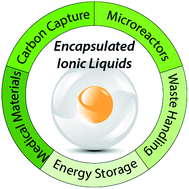Engineering encapsulated ionic liquids for next-generation applications
Abstract
Ionic liquids (ILs) have attracted considerable attention in several sectors (from energy storage to catalysis, from drug delivery to separation media) owing to their attractive properties, such as high thermal stability, wide electrochemical window, and high ionic conductivity. However, their high viscosity and surface tension compared to conventional organic solvents can lead to unfavorable transport properties. To circumvent undesired kinetics effects limiting mass transfer, the discretization of ILs into small droplets has been proposed as a method to increase the effective surface area and the rates of mass transfer. In the present review paper, we summarize the different methods developed so far for encapsulating ILs in organic or inorganic shells and highlight characteristic features of each approach, while outlining potential applications. The remarkable tunability of ILs, which derives from the high number of anions and cations currently available as well as their permutations, combines with the possibility of tailoring the composition, size, dispersity, and properties (e.g., mechanical, transport) of the shell to provide a toolbox for rationally designing encapsulated ILs for next-generation applications, including carbon capture, energy storage devices, waste handling, and microreactors. We conclude this review with an outlook on potential applications that could benefit from the possibility of encapsulating ILs in organic and inorganic shells.

- This article is part of the themed collection: 2021 Reviews in RSC Advances


 Please wait while we load your content...
Please wait while we load your content...